USDOT Thriving Communities Program: Isabela, PR
25 minutes Date Launched/Enacted: May 28, 2025 Date Published: May 28, 2025
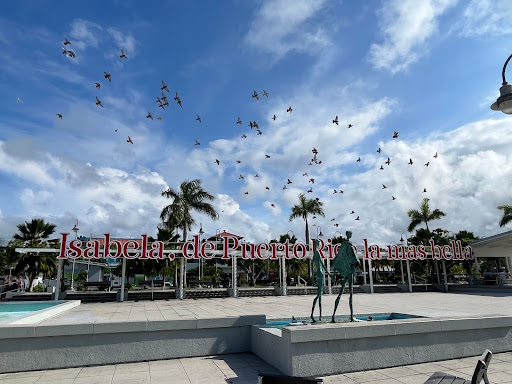
Para leer este artículo en Español, haz clic aquí.
About the Thriving Communities Program (TCP)
The Thriving Communities Program (TCP) funds tailored technical assistance to under-resourced and disadvantaged communities, helping them better access historic infrastructure investments and deliver transformative projects. The USDOT FY 2022 Thriving Communities Program supports 64 communities across the country with access to a team of capacity builders to develop innovative community engagement methods, identify funding opportunities, and grow long-term capacity to develop and deliver transportation projects that strengthen communities.
TCP Complete Neighborhoods Community of Practice
TCP Communities are grouped into three Communities of Practice: Main Streets, Networked Communities, and Complete Neighborhoods. The 15 communities included under the Complete Neighborhoods Community of Practice are:
| Atlantic Beach, SC | Isabela, PR | Santa Cruz, CA |
| Billings, MT | Lansing, MI | St. Louis County, MO |
| Decatur, IL | Lima, OH | Suffolk, NY |
| East Orange, NJ | Providence, RI | Sumter, SC |
| Indianapolis, IN | Roanoke, VA | Waukegan, IL |
The US Department of Transportation (USDOT) selected a capacity building team led by RMI, including: the American Council for Energy-Efficient Economy (ACEEE), Equitable Cities, Nelson\Nygaard, and the Shared-Use Mobility Center (SUMC), to provide technical assistance to these 15 communities.

A Snapshot of Isabela, Puerto Rico
The Municipality of Isabela is located in the northwestern region of the island of Puerto Rico. It is one of 78 municipalities in the Commonwealth of Puerto Rico, and part of the Aguadilla metropolitan area. At the time of the 2020 US Census, the Municipality of Isabela had a population of 42,943, slightly down from the 45,632 recorded at the 2010 US Census, which ranks Isabela as Puerto Rico’s 18th most populous municipality. Like most of Puerto Rico’s population, Isabela’s population is predominantly Hispanic. Its median household income is $17,123, below the $24,112 average for Puerto Rico. Isabela’s poverty rate reaches 50% of its total population. Isabela’s disability rate reaches 25.7%, including 19% of people under age 65, and 5.6% of the total population lacks health insurance. In terms of education, 76.6% of residents aged 25 and older have completed at least high school, and 25.4% hold a bachelor’s degree or higher. 69.6% of Isabela’s households have a computer and only 47.9% have a broadband internet subscription.
The Municipality of Isabela’s 14 wards spread across a diverse geography, ranging from the coastal neighborhoods with sandy beaches that attract tourism, an urban downtown concentrating commercial and services activities, sparse rural agricultural communities, and small communities living in forest areas around the Guajataca State Forest. Isabela’s local economy is powered by international and local tourism, small businesses, professional services, light manufacturing, and agricultural activities. Isabela is considered one of the best beach towns in Puerto Rico, which is captured in the town’s motto “The most beautiful of Puerto Rico.”
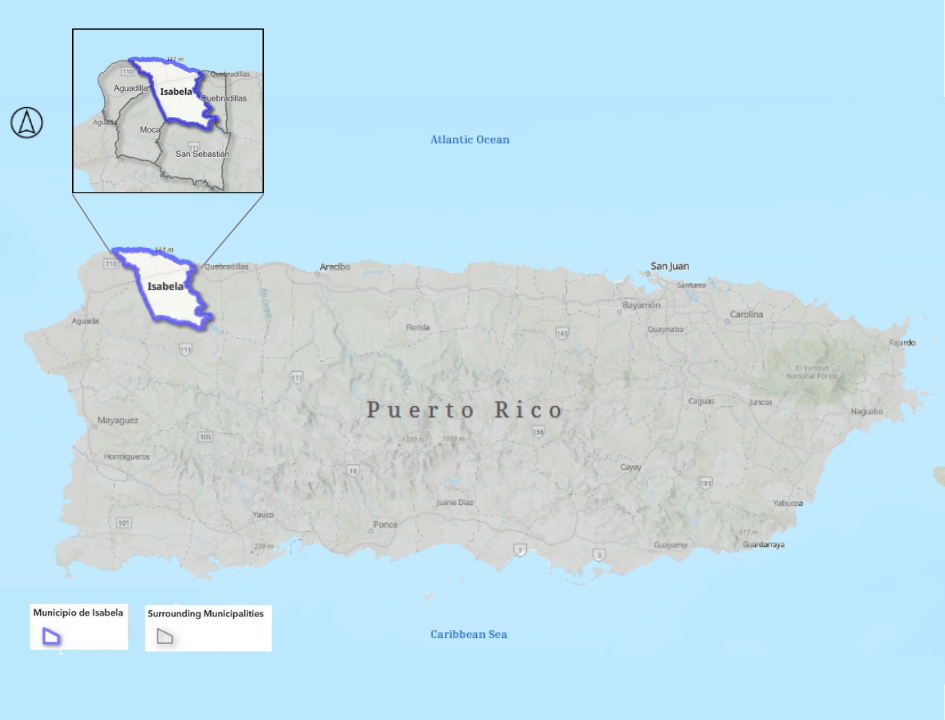
Location of Isabela within Puerto Rico and neighboring municipalities. Credit: SUMC
Isabela’s transportation landscape includes: access to PR Highway 2, the main roadway connecting Isabela to the cities of San Juan to the east, Aguadilla to the west, and Mayagüez to the southwest. While most international visitors to Isabela arrive in Puerto Rico through the Luis Muñoz Marín International Airport (SJU) located in San Juan, Isabela benefits from its proximity to the Borinquen Airport (BQN) located in the neighboring Municipality of Aguadilla, which is undergoing an expansion of its capacity supported by FAA’s Airport Terminal Program grants and it is expected to become a key economic activity driver for the region. Notably, Isabela is home to the one of a kind Museo del Tren de Puerto Rico, a museum dedicated to preserve and promote Puerto Rico’s railroad history, since Puerto Rico’s freight and passenger service ended in the 1950s, and most of its infrastructure and vehicles suffered from abandonment, vandalism, or dismantling. Currently, Isabela does not have public transit service, but the Municipality offers a limited dial-a-ride service and has been working towards establishing some form of public transit. Isabela’s famous Paseo Tablado is a scenic coastal pedestrian and bike trail. A privately operated micro mobility rental shop provides tourists options to ride it by bike or scooters. Given Isabela’s popularity as a tourist destination, accommodating parking for cars at peak times, and during special events can be challenging for locals and visitors alike. Despite being a coastal community, Isabela does not possess a port or pier to accommodate maritime transportation.
As a coastal community, Isabela faces significant climate risks, including extreme heat, coastal flooding, and the long term impacts of the 2017 Hurricane Maria. Among other programs supporting Isabela’s effort to mitigate, prepare, and address natural disasters, Isabela participates in the Whole Community Resilience Program (WCRP), which is supported by the Puerto Rico Department of Housing (PRDOH). Through this program, the Municipality has conducted extensive community engagement across all communities in Isabela to create a resilience plan that identifies vulnerable areas and populations and strategizes ways to mitigate climate change risks.
Since tourism is a key local economic development driver, Isabela invests in leveraging the variety of natural, cultural, and historical attractions it has to offer. The Isabela’s Office of Tourism leads the town’s efforts aimed to attract more visitors to town, and also to develop opportunities for visitors to engage in multiple activities while in town to promote economic development across the community. Promotional campaigns like Ven a Isabela have been successful at positioning Isabela as a welcoming community.
Isabela’s economy benefits from its beaches’ international reputation, especially among the surfing community. Isabela’s surfing landscape has been a significant attraction for local and international visitors, positioning the town as a top tourist destination of Puerto Rico, accommodating both family-oriented tourism with surfing competitions, like the 2024 Corona Pro Surf Circuit, and bringing a wide diversity of visitors to the town.
Isabela is also well-known for its vast cultural activities, including annual festivals and weekly events, which reflect Isabela’s commitment to preserving its traditions and promoting its culture, as well as offering enriching and memorable experiences for both residents and visitors. Among other activities, Isabela annually hosts: religious festivals – such as the Patron Saint Festival of San Antonio de Padua and the Three Kings Festival – food related festivals – including Isabela Tiene Sabor and the Yuca Festival -, craft related festivals – Puerto Rican Weaving Festival and the Kite Festival-, and musical festivals – such as the Isabela International Tango Fest. Furthermore, on a weekly basis, Isabela’s main plaza hosts the Noche de Artesanía y Arte (Crafts and Arts Night) on Wednesdays, and its Viernes de Salsa (salsa nights) on Fridays. Isabela is also home to famous salsa singer Victor Manuelle, who grew up in Isabela, and to the Luis Muñoz Rivera public school’s School Band.
Key Initiatives for Transportation
Through community engagement efforts involving different population groups and disadvantaged communities within the Municipality of Isabela, the project team identified and prioritized six transportation projects to foster with TCP support.
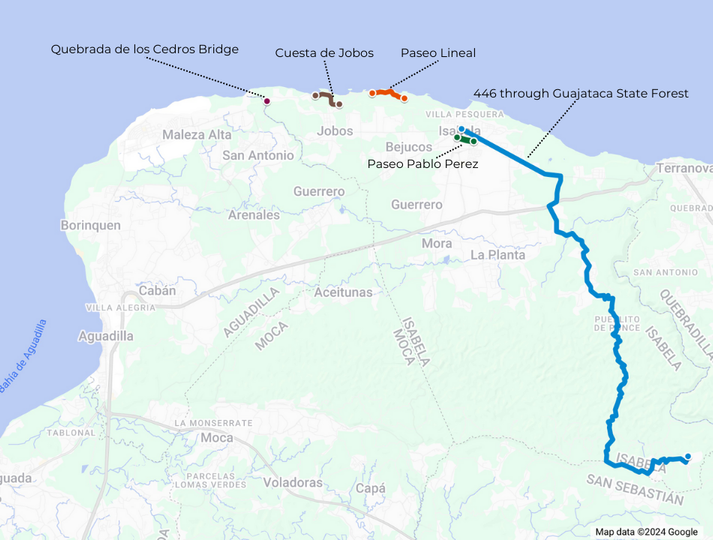
Location of key transportation projects in Isabela. Credit: SUMC
Paseo Lineal
A coastal path in Isabela that serves as both a recreational and tourist route and connects coastal communities. It features three sections with diverse infrastructure: a two-way road, a dedicated active transportation path, and an elevated coastal boardwalk known as the Paseo Tablado. Maintenance and improvements are needed, and Isabela is exploring options to enhance safety, strengthen coastal resilience, and upgrade infrastructure. The Paseo Lineal also provides opportunities for community engagement, collaboration with educational organizations, and integrating climate-resilient design elements.

Images of the Paseo Lineal. Credit: SUMC
PR-266 is the main route connecting the town of Isabela with Jobos beach, one of the most popular destinations for locals and international tourists. Given the Cuesta de Jobos road’s steep incline and its location next to a cliff-facing forest, the project is working on improving road safety infrastructures and devices that are essential to prevent accidents, enhance wayfinding, and improve connectivity.

Map of area and images of PR-466 at the Cuesta de Jobos. Credit: Municipio de Isabela and SUMC
Quebrada de los Cedros bridge (PR- 4466)
This key bridge, located on PR-4466, is one of the few roads connecting Isabela to the neighboring Municipality of Aguadilla. This bridge is a critical connection to transport passengers and goods between Isabela and Aguadilla, as well as it serves as a vital tsunami and natural disasters evacuation route for the people of the Bajuras neighborhood. The bridge is subject to flooding and needs improvements to ensure its structural integrity and to continue to provide a safe road for commerce and emergencies.

Aerial view and Images of PR-4466 at Quebrada de los Cedros. Credit: Google Earth and SUMC
Isabela to Planas through Guajataca State Forest (PR-446)
Road 446 is a vital link for the community of Planas, located in the southeast corner of the Municipality of Isabela and separated from the town and its essential services by the Guajataca State Forest. The road’s unsafe conditions stem from environmental wear, natural disaster impacts, and a fragmented oversight involving multiple local and state agencies. Potential improvements to PR-446 will require interagency coordination, innovative road designs that prioritize safety while respecting the natural surroundings, and significant investment. Upgrading this vital route is essential for enhancing connectivity and accessibility for the residents of the Planas community.

Images of PR- 446 through Guajataca State Forest, and at Planas. Credit: SUMC
Paseo Pablo Perez
Paseo Pablo Perez, a centrally located street in Isabela at the downtown’ south edge, has long been in disrepair, and the Municipality sees its location as an opportunity to revitalize it as a vibrant community space. The Paseo Pablo Perez is located near the Irma Deliz de Muñoz Middle School, the Boys & Girls Club of Isabela, and the Club de Leones de Isabela, all of them community institutions that host activities with people of all ages that can benefit from a more accessible, inviting, and beautiful Paseo. The western edge of the Paseo Pablo Perez houses the Municipality of Isabela’s Recycling Department headquarters, equipment storage facility, and community recycling facilities.
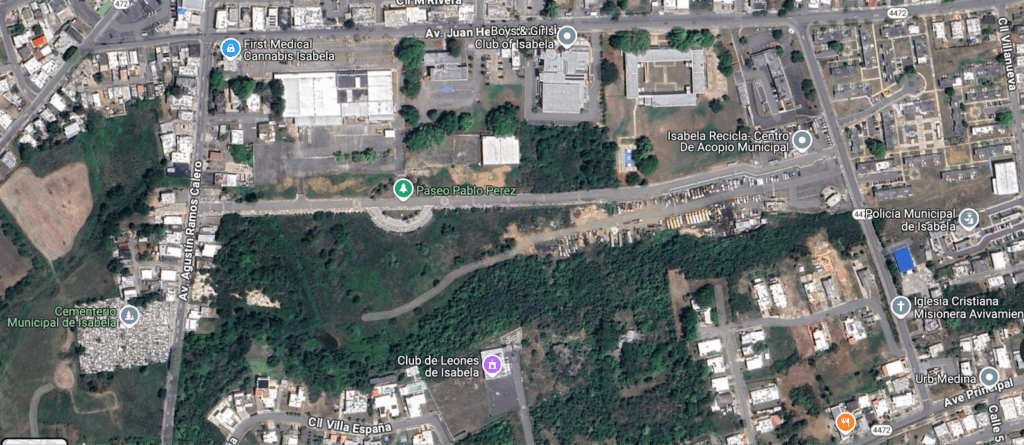
Aerial view of Paseo Pablo Perez. Credit: Google Maps
Recently, Isabela has hosted temporary events like farmers’ and artisans’ markets, showcasing its potential as a community gathering space. Plans for the future of the Paseo Pablo Perez include transforming it into a safe, attractive destination by adding green infrastructure, flexible spaces for community activities, and establishing it as a demonstration site for both temporary and permanent placemaking, safety, and beautification initiatives.
Thinking bigger, the Municipality of Isabela has identified an opportunity to leverage the investments on the Paseo Pablo Perez to create an Urban Forest along the neighboring parcels south of the Paseo Pablo Perez that are currently an undeveloped forest area. The Municipality is currently developing projects and proposals seeking to raise funding and support to implement this vision.
Partnership with Universidad de Puerto Rico – Mayagüez
Upon learning that several transportation projects in Isabela are related to environmental and coastal conditions, the TCP Capacity Builder team identified an opportunity to connect the Municipality of Isabela with the technical and academic resources at the University of Puerto Rico-Mayagüez (UPR-M). The UPR-M is a key academic institution in Puerto Rico, home of a prestigious transportation engineering program, and a participant university of the USDOT’s University Transportation Centers as part of the Coastal Research and Transportation Education program.
The UPR-M is also the designated host of Puerto Rico’s Local & Tribal Technical Assistance Program, an island-wide technical assistance program funded by the Federal Highway Administration and Puerto Rico Department of Transportation and Public Works, that provides technical assistance, educational resources, and workforce development support.
The geographical proximity between Isabela and Mayagüez to facilitate exchanges between municipal staff and academic researchers, as well as the fact that Isabela’s coastal and rural communities align with the subject of research interest of UPR-M’s projects, unlocked the exploration of mutually beneficial collaborations.
Key Partners
Isabela is working with several key partners on these initiatives. Some of these partners include:

Stakeholder Map. Credit: SUMC
- The Love Crew Inc is a local nonprofit organization supporting capacity building for community projects, committed to sharing God’s love through service, charity, and education to improve the overall wellness of the communities and prevent cruelty in children and animals. They have served the communities helping them get through difficult times, such as hurricane Maria and the recent earthquakes. In addition, they have developed projects to assist people in acquiring new skills, improving their mental health, and starting their own business while developing their emotional intelligence and problem-solving abilities.
- Conservación Costera Puerto Rico (CoCoPR) is a local non-profit organization created in 2018 with the opportunity to revitalize the Guajataca Tunnel. Thanks to an established collaboration with Foundation for Puerto Rico, and its Bottoms Up initiative, CoCoPR launched its self-managed project receiving broad support from the Isabela community and surrounding villages.Together with municipal entities, non-profit organizations, traders, voluntary groups and community individuals, the revitalization of the Tunnel was a success that culminated in 2020. CoCoPR continues to organize the coastal community. The organization currently has a solid base of collaborators who contribute and add value to efforts to conserve our coasts around the island.
- Mi Patria Puerto Rico is a newly formed nonprofit organization that aims to improve the quality of life of underserved Puerto Rican communities by addressing displacement and providing sustainable and affordable housing, educational resources and support services to assist in their growth and development. The organization focuses their work on supporting military veterans and seeks to protect and expand affordable housing options to create resilient, self-sufficient communities.
- University of Puerto Rico – Mayaguez / Puerto Rico Transportation Technology Transfer Center was created on April 1, 1986, in the Department of Civil Engineering and Surveying of the University of Puerto Rico, Mayagüez Campus. Initially, the Center was part of the Federal Highway Administration Rural Technical Assistance Program (LTAP) that emphasized technical assistance to local transportation officials in rural communities. With the approval of the Intermodal Surface Transportation Efficiency Act (ISTEA) in 1991, the program was changed to the present Local Technical Assistance Program (LTAP) and included technical assistance to urban areas.
Other Community Partners
- Viva La Vida is a local non-profit organization dedicated to prevent suicides through support hotline, health resources, and community events. Viva La Vida have organized bike rides, walking events, and other mobility related events as an avenue to create awareness about suicide prevention and to bring communities and families together.
- Sketzii: Sketzii (Ketsy Ruiz), a painter, digital illustrator, and muralist, conveys her ethnic identity and culture in her art. Growing up in the Puerto Rican diaspora of the United States greatly inspires her work. Living all over the U.S she was constantly seeking community and found diaspora Latinx wherever she traveled to.
- Michael “2ESAE” Baca is a Puerto Rican artist residing in Aguadilla, Puerto Rico, creating bold and iconic mixed media art pieces.Michael’s go-to mediums include silk screening, photography, and graffiti art. Committed to empowering the next generation, Michael engages with youth, teaching them about various cultures, the art of graffiti, and the importance of confidence and self-expression.
Activities through the Thriving Communities Program
Stakeholder Mapping
From the early stages of the Thriving Communities Program and to the very last activities, the Capacity Builder team has supported an assessment of existing community engagement capabilities, resources, and initiatives. Through this process, the team identified opportunities to expand engagement with community-based organizations, as well as to involve state and federal agencies in local planning initiatives.
Isabela is remarkably rich in community based organizations (CBOs). Isabela’s CBOs work in a wide range of community activities, including: historic preservation, environmental sustainability, housing and workforce development, inclusion of people with disabilities, faith-based organizations, youth development, musical promotion, animal shelters, health and human services, to name a few. Isabela has a large number of CBOs and a remarkable social life based on the amount of activities these CBOs collectively engage in. The Municipality of Isabela encourages and supports the work of local CBOs, facilitating spaces to host activities, providing technical resources, promoting community events, and seeking avenues to improve growth and coordination among CBOs.
At the regional level, the Capacity Builder team explored with Isabela opportunities for collaboration with neighboring municipalities, to develop joint projects addressing common challenges and to increase the region’s competitiveness in applications to discretionary federal grant programs. The team also considered how Isabela may benefit from regional collaboration with Aguadilla in leveraging current and future economic and workforce development opportunities tied to the expansion of the Aguadilla / Borinquen (BQN) airport, as well as in the development of public transit options connecting the two towns.
With the support of the Capacity Builders team, the Municipality of Isabela opened the door to exploring partnerships with the University of Puerto Rico at Mayagüez (UPR-Mayagüez), which hosts Puerto Rico Local and Tribal Technical Assistance Program, as well as a research program focused on studying climate impacts on coastal communities.
At the state level, the team identified that the Municipality of Isabela can benefit from coordinating with the Puerto Rico Department of Transportation (DTOP) to advance critical infrastructure projects, especially on state-owned roads. The stakeholder mapping highlighted collaboration with the Puerto Rico Department of Natural Resources and the Environment (DRNA) to address urgent repairs on Route 446, which connects Planas to the municipality’s downtown and PR Highway 2. As well as coordination with other state agencies such as the Puerto Rico Department of Transportation and Public Works (SDOP), The Highways and Transportation Authority (ACT), Puerto Rico Department of Natural Resource and Environment (DNRA), and the Puerto Rico Transportation Technology Transfer Center.
At the federal level, engagement with federal agencies like the Under Secretary of Transportation (USDOT), as well as the Federal Highway Administration (FHWA), and Federal Transit Administration (FTA) regional offices, is crucial for addressing road safety issues, advancing transit service plans, and conducting site visits to assess climate impacts and prioritize future projects.
First Site Visit
On May 6-7, 2024, the Capacity Builder team led a two-day site visit to Isabela, supporting the Municipality of Isabela in engaging with local, state, and federal stakeholders in discussing key local challenges and opportunities to improve mobility and transportation infrastructure.
The site visit started with an introduction to the Thriving Communities Program, followed by a welcome from Isabela’s Mayor Miguel “Ricky” Mendez, who shared his vision for Isabela’s future, focusing on building stronger infrastructure after recent natural disasters and turning the town into a hub for tourism and economic growth.
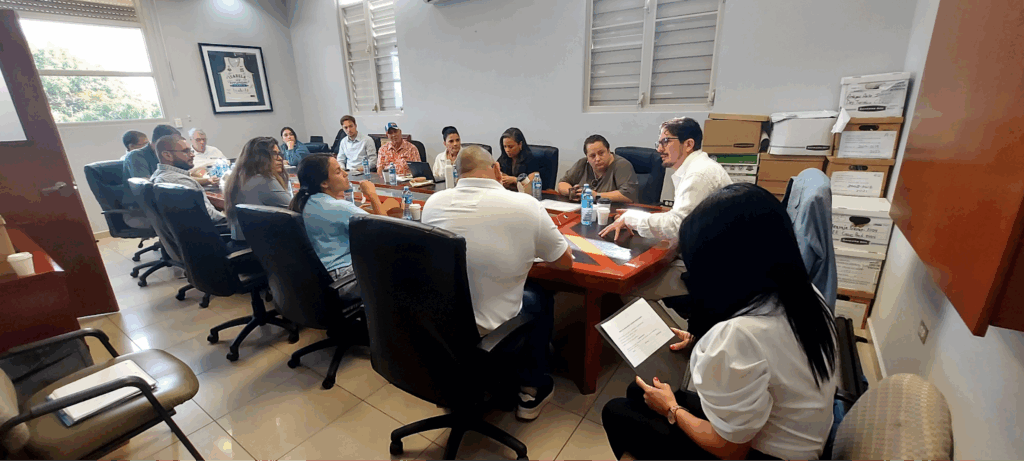
View of the Capacity Builder team meeting with local, state, and federal stakeholders. Credit: Municipio de Isabela
TCP site visit activities included multiple conversations discussing the state of transportation infrastructure in Isabela, prioritizing key transportation projects to pursue, and identifying potential funding opportunities to support those investments.
Some highlights from these conversations included identifying which (local, state and/or Federal) agencies have jurisdiction over the PR-446 through the Guajataca State Forest. This has been a long standing issue for the Municipality. Since multiple agencies have jurisdiction over the road and/or are recipients of grants that impact the area where the road goes, the Municipality was struggling to identify all relevant stakeholders needed to engage in surface transportation projects aiming to improve road and safety conditions along PR-446. The TCP site visit dedicated a session to engage representatives from the State DOT, FHWA, Puerto Rico’s Department of Natural Resources, and the Municipality in resolving this question.
In addition to workshop conversations, stakeholders participated in a field trip to the community of Planas through the Guajataca Forest along PR- 446, where the team experienced first-hand the state of roads and infrastructure, and to gain a better understanding of the challenging road conditions that the residents of Planas, tourists visiting the Guajataca forest’s attractions, and the government of Isabela delivering municipal services face when driving on PR-446. The field trip also included a conversation over lunch with Planas community stakeholders who shared their concerns about their isolation given PR-446’s conditions, and how improving this road would be a critical investment to reconnect this community with the rest of Isabela.

A stop at a DNRA shelter at the Guajataca Forest during the field trip to Planas along PR-446. Credit: SUMC
Another transportation project that benefited from conversations with federal and state stakeholders was Isabela’s initiative to develop a public transit service. Since the Municipality currently does not have public transit service and it is not an eligible recipient of Federal Transit Administration’s funds, the participation of FTA Region IV staff at the site visit enabled Isabela to gain guidance on the process to potentially establish a local public transit system.
Finally, the conversations with multiple stakeholders approaching Isabela’s transportation need in a comprehensive way provided an unique opportunity to match each transportation project with potential funding opportunities, including State funding and federal competitive grants such as Safe Streets for All (SS4A), the Promoting Resilient Operations for Transformative, Efficient, and Cost-saving Transportation (PROTECT), and the Bridge Investment Program (BIP).
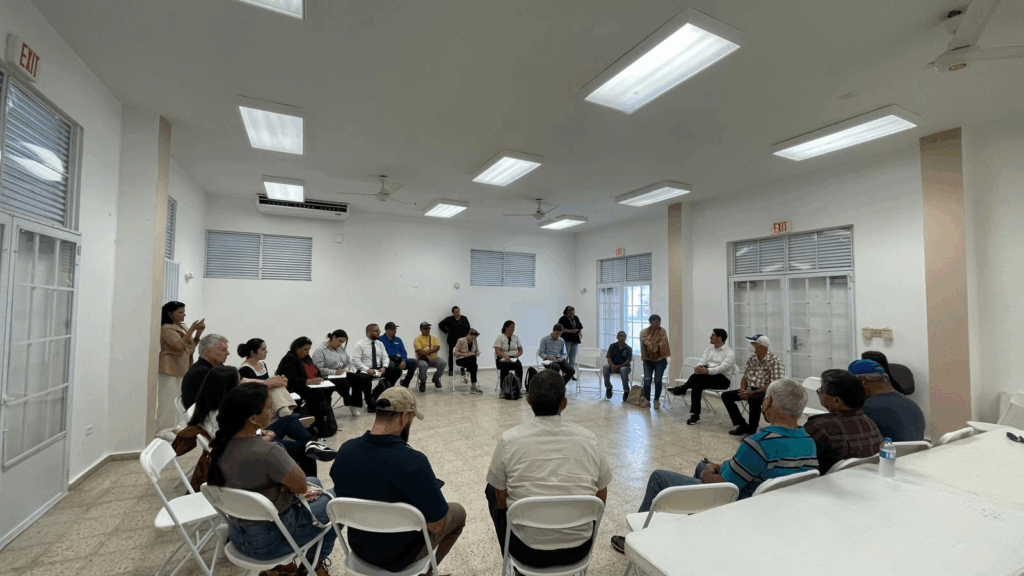
View of the community meeting with local stakeholders of Planas. Credit: Municipio de Isabela
The second day of the TCP site visit focused first on a field trip and on site discussions about Isabela’s coastal areas. The team assessed on site conditions for the access points to the Jobos community (a key touristic and economic driver for Isabela), the scenic Paseo Lineal, and other key coastal sites vulnerable to flooding, hurricane, and storm damage such as the roads in Villa Pesquera and the bridge connecting the neighborhood of Bajuras with Aguadilla.
The last part of the field trip focused on discussing opportunities to improve access and economic development to Isabela’s historic and cultural sites, including the site of the Cara del Indio Mobadamaca, the tunnel of Guajataca (one of the more iconic remaining sites of Puerto Rico’s dismantled railroad infrastructure), and the early colonial ruins of San Antonio de la Tuna.
The site visit activities wrapped up with a roundtable discussion, setting clear actions and timelines to move forward, providing a new sense of collaboration, and preparing for the next steps, including working on Isabela’s Safe Streets for All grant application.
Transportation Needs Assessment Survey
With support from the Capacity Builder team, Isabela developed a Mobility Needs Assessment survey to identify key gaps in transportation infrastructure and mobility services. The survey asks questions related to how people move, what are their key destinations, what are the gaps in accessing transportation services or infrastructure, what are the housing and household conditions that impact their transportation needs, in addition to more general demographic questions to understand the universe of respondents. The survey’s goal is to shape future transportation planning efforts as well as to gain insights about how community transportation needs relate to other community needs and investments in areas such as housing, employment, education, recreation, and medical services.
The survey has been designed and disseminated in Spanish, aiming to receive as many responses as possible from a predominantly Spanish speaking local population. The survey has been promoted through multiple local partners, as well as during the revitalization of Paseo Pablo Perez community event.
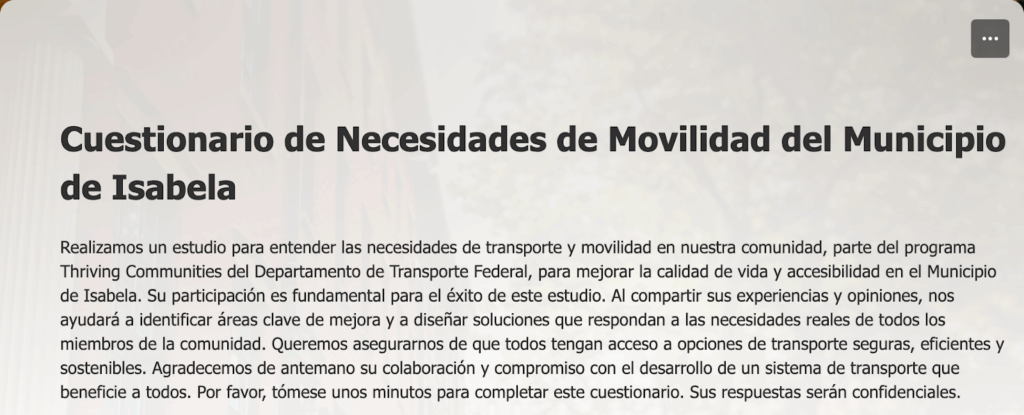
Screenshot of the form used for the Mobility Needs Assessment survey in Isabela. Credit: The Love Crew
Partnership with University of Puerto Rico – Mayagüez
Following the stakeholder mapping exercise that identified the University of Puerto Rico – Mayagüez (UPR-M) as a potential partner to collaborate with Isabela, as well as for Isabela to tap into the technical assistance resources provided by the Transportation Technology Transfer Center (TTTC) based at the UPR-M, the Capacity Builder team facilitated the initial conversations between the two teams. First, by hosting a series of meet-and-greet virtual meetings serving as an introduction to learn about the work, capabilities, and needs of both the municipality and the university. These initial virtual meetings resulted in the identification of a few potential areas of collaboration, including resiliency research projects, technical support for transportation initiatives along Isabela’s coast, and informational and educational exchanges between the two teams regarding state and federal transportation programs.
After a round of virtual meetings, the TTTC team led by its two co-directors, participated in the TCP site visit activities on May 6-7, 2024. The in-person meeting provided a unique opportunity to exchange information about ongoing projects, to foster relationships between the UPR-M team and the Municipality of Isabela’s staff (leveraged by the fact that some of Isabela’s staff members are graduates from the UPR-M), and to introduce the UPR-M team to multiple community-based organizations in Isabela. A highlight of this TCP activity was the UPR-M team participation in the field trips visiting the road along the Guajataca Forest (PR-446) and especially the opportunity to see and discuss on the ground the roads and transportation infrastructure conditions along Isabela’s coast. Through conversations entertained during that field trip, the UPR-M team and Isabela’s stakeholders started a path to collaborate on research projects led by the UPR-M’s team under the Coastal Research and Transportation Education (CREATE) program. Given the interests in this potential collaboration, the UPR-M team delivered an unscheduled presentation at the end of the TCP site visit to provide a snapshot of the CREATE program and the research projects that the Municipality of Isabela and local CBOs could support.
Following the TCP site visit, on September 27, 2024 members of the UPR-M CREATE research team visited Isabela to expand the conversations initiated in April. During that visit, the research team assessed the conditions at several locations and decided to designate two of Isabela’s key transportation projects along the coast as research sites using two of the CREATE program’s research models: the Enhanced Visualization Technology to Assess the States of Coastal Transportation Infrastructure; and the Resilience-based Decision Support System for Critical Transportation Corridors.
The data collection efforts to inform the study included gathering and analyzing publicly available information from multiple databases hosted at different federal agencies. Additionally, the CREATE team developed and administered a survey identifying Isabela residents’ perceptions about risks related to extreme natural disasters and the state of the transportation infrastructure along the coastal corridor, and conducted several interviews with residents and municipal staff to inform the study.

Screenshot of the form used for the Perceptions about Natural Disasters and Transportation in Coastal Areas survey in Isabela. Credit: Coastal Research and Education Actions for Transportation Equity (CREATE), University of Puerto Rico at Mayagüez.
On April 26, 2025, a CREATE team including two faculty members and four students participated in a TCP community event and presented to the people of Isabela the preliminary results of their research studies.

University of Puerto Rico at Mayagüez CREATE program faculty and students participate in TCP site visits to assess conditions in 2024 and present research studies about Isabela’s coastal projects in 2025. Credit: SUMC
Revitalization Paseo Pablo Perez
The Paseo Pablo Perez is a ¾ mile long street located in Isabela urban core. The Paseo has been a neglected space despite its central location and its connection to many destinations such as the Boys and Girls Club, the Irma Deliz de Muñoz Middle School, the Municipality’s Recycling Office, apartments neighborhood, and the shopping plaza (currently closed). The street is most of the time closed to traffic with concrete barriers, which has contributed to the perception of the space as abandoned, unsafe, and inaccessible.
The Municipality of Isabela embarked on a project to revitalize the Paseo Pablo Perez as a way to create a safe and beautiful public space for the community to enjoy, for community activities, and for economic development in that part of town.
The Capacity Building Team facilitated conversations between the Municipality of Isabela and community-based organizations to identify initiatives and investments necessary to revitalize the Paseo. Through a series of stakeholder meetings, the brainstorming sessions provided multiple ideas for infrastructure, amenities, and activities that could improve the Paseo. Some of the proposed initiatives were not eligible to receive support from the TCP program (e.g. installing permanent safety infrastructure on the street). At the end of the day, the team put together a three-phase plan to initiate the process of revitalization:
Phase 1: Sustainability and Local Economic Development through Native Trees and Farmers Markets
For the first phase, the Municipality of Isabela partnered with Conservación Costera Puerto Rico (CoCoPR), a local non-profit organization working to restore and protect Isabela’s natural assets, to engage youth and community members in sustainability projects, and to create conditions for locals and tourists to enjoy nature.
CoCoPR’s-led project included planting over 100 native trees along the corridor to enhance the resiliency, appeal, and beauty of the space, to support stormwater management, and to create over time an urban tree canopy that reduces heat island effects and provides shade for vendors and visitors of the Farmers Market along the Paseo.
CoCoPR proposal also included hosting the Mercado Agrosoteño (farmer and artisans’ market) on a monthly basis. The Paseo Pablo Perez provides a suitable space to host a farmers market given its design as a corridor with a central plaza that facilitates both the installation of vendors’ booths and a pleasant shopping experience for visitors. By hosting a monthly market at the Paseo Pablo Perez, CoCoPR has created a regular event for vendors, residents, and visitors to experience the Paseo, and an opportunity to inform future improvements.

Images of tree planting works and a session of the Mercado Agrocosteño at Paseo Pablo Perez. Credits: Conservación Costera Puerto Rico
Social media video inviting people to visit the Mercado Agrocosteño. Credit: Conservación Costera Puerto Rico
Phase 2: Beautification and Placemaking through Community Artistic Murals
For the second phase, the Municipality of Isabela partnered with Mi Patria PR, a local nonprofit organization improving quality of life through housing, education, innovation, and community engagement programs. Mi Patria PR’s project consisted in creating a series of murals along the Paseo designed to give the space a visual identity that represents Isabela’s community, turning the Paseo from a cement-grey looking street into a colorful space, and to create opportunities for families to connect and enjoy their time in a safe, welcoming environment.
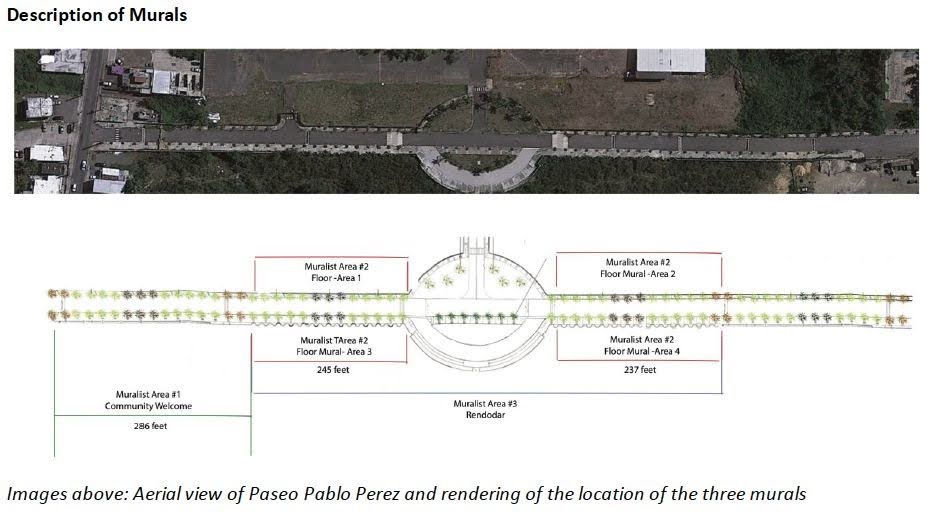
Aerial view of Paseo Pablo Perez and rendering of the proposed locations of the community murals. Credit: MiPatria PR
Isabela’s Recycling Department team, whose main office and facilities are located in the vicinity of the Paseo Pablo Perez, was in charge of preparing the urban canvas to support the installation of the artistic murals, including making repairs to the street and powerwashing the sidewalks and walls surfaces.
For the production of the murals on Paseo Pablo Perez, MiPatria PR invited two Puerto Rican artistic teams to lead the original design of the murals and coordinate the painting work: one led by Sketzii and one by Michael Baca. The vision and work of the artists was supported by the engagement of around 40 volunteers from the community that over the course of several weeks worked on bringing color to the artistic imagery along the Paseo. MiPatria PR documented the transformation of this space through art and community participation, and shared pictures and videos of the progress of the murals painting work on social media.

Images showing progress in the painting murals along the Paseo Pablo Perez, including artist Michael Baca and community volunteers. Credit: MiPatria PR
Video of the mural painting process. Credit: Mi Patria PR
Phase 3: Community Event Opening Revitalized Paseo Pablo Perez in conjunction with Earth Day
For the last phase, the Municipality of Isabela partnered with The Love Crew, a faith-based local nonprofit investing in local capacity and supporting community projects, to organize and host a community event to officially open to the public the revitalized Paseo Pablo Perez.
A key objective of the community event was to create a vibrant gathering place that promotes recreation and community safety, ensuring it is free and accessible to everyone, including youth, our aging population, and individuals with diverse abilities. To this purpose, The Love Crew invited a wide variety of community-based organizations, musicians, and artisans to participate in the event. The event was also designed to support local business, including food trucks, local artisans, and professional services’ booths along the Paseo.
The Municipality identified an opportunity to host this community event celebrating the works of revitalization of the Paseo Pablo Perez as part of the annual activities that Isabela’s Office of Recycling organizes for Earth Day. Therefore, the date for the event was set for April 26, 2025.
The event was promoted via social media, flyers and banners placed at local businesses and key road intersections, and media coverage in local newspapers and radio.

Public announcement of the community event at the Paseo Pablo Perez, shared through social media, flyers at local front stores, and banners at key intersections. Credit: Municipio de Isabela’s Facebook, and SUMC
Community Event
Residents of Isabela and neighboring communities of all ages, tourists, local vendors, artists, community-based organizations and project stakeholders gathered for the festive, day-long inauguration of the revitalized Paseo Pablo Perez. Despite the rain at the beginning of the event, over 400 people visited the event during the course of the day. In addition to attendees enjoying the newly inaugurated murals, planted trees, lighting, and seating, event activities included:
- a 3-kilometer (0.6 miles) walk/run race for people with dogs
- Five artistic performances from local bands including salsa, rock, and batucada
- A children entertainer and children’s inflatable playground station
- A performance by Isabela’s School Band.
- Participation of over 30 local artisans and food vendors sold their products on the strip,
- 8 local CBO’s hosted booths and presented their work and mission to the community,
- The PR State Road Safety Agency provided informational and educational resources
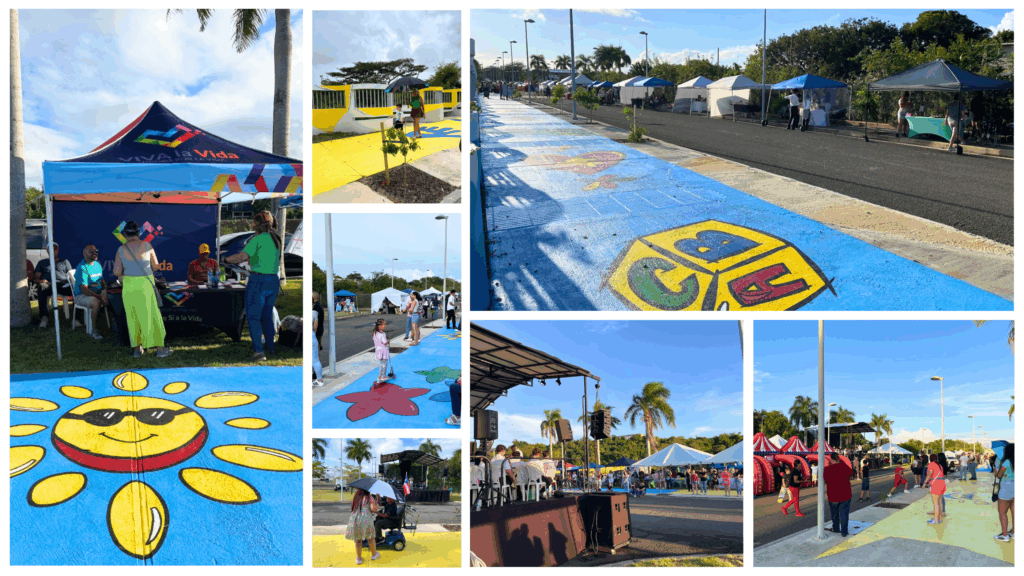
Images of the community event at Paseo Pablo Perez on April 26, 2025. Credit: SUMC
Video of the community event at Paseo Pablo Perez on April 26, 2025. Credit: The Love Crew
With the completion of these initial investments for the revitalization of the Paseo Pablo Perez, Isabela has an opportunity to take advantage of the momentum created during TCP to leverage this community asset for the enjoyment of everyone in Isabela, local residents and visitors alike.

Views of the murals at the Redondel of the Paseo Pablo Perez. Credit SUMC
Second TCP Site Visit
The Capacity Builder team hosted its second site visit to Isabela in conjunction with the inauguration of the revitalized Paseo Pablo Perez. The site visit achieved three goals:
- To participate in the community event to provide information to the community about the TCP program, its impacts and capacity building resources provided to the community;
- To meet in person with the community-based organizations engaged through TCP, to celebrate their contributions to TCP’s initiatives, and to suggest additional resources and opportunities to pursue beyond TCP
- To debrief with the Municipality of Isabela team about the community event, to brainstorm opportunities to leverage the investments made at the Paseo Pablo Perez and through the community engagement initiative along TCP, and to wrap-up the capacity building support in relation to advancing local transportation projects, identifying sources of funding, and preparing for the implementation of the work through the FY24 Safe Streets for All grant that Isabela was awarded.

Capacity Builder team booth at the community event, and Capacity Builder team with CoCoPR, the Municipality of Isabela’s, The Love Crew, and Mi Patria PR during the Paseo Pablo Perez community event. Credit: SUMC
Funding Opportunities
Before getting selected as a FY22 TCP community, the Municipality of Isabela pursued other federal transportation grant programs to support their transportation programs. Among others, Isabela applied to an FY22 Reconnecting Communities Pilot (RCP) Discretionary Grant Program for planning activities for their Jobos Community Connectivity Project seeking to address safety and connectivity issues along PR-466 connecting Isabela and Jobos. Unfortunately, this project was not awarded a RCP grant.
Safe Streets for All FY24 Grant is a competitive program from the U.S. Department of Transportation (USDOT) that provides funding for local governments, metropolitan planning organizations, and tribes to improve roadway safety. The program’s goals include reducing the number of roadway deaths and enhancing safety for all road users. Isabela successfully applied for this grant, making it the only municipality in PR to receive funding through this grant program and the first time Isabela has received a federal grant to develop or update an action plan and conduct demonstration or other supplemental planning activities.
Additionally, Isabela is planning to apply for the Promoting Resilient Operations for Transformative, Efficient, and Cost-saving Transportation (PROTECT) Grant program. The program provides funding to ensure surface transportation resilience to natural hazards, including climate change, sea level rise, flooding, extreme weather events, and other natural disasters, through support of planning activities, resilience improvements, community resilience and evacuation routes, and at-risk coastal infrastructure.
Related Resources
Communications
- Municipio de Isabela Facebook Page
- Ven a Isabela (Isabela Office of Tourism campaign)
- CoCoPR Instagram
- MiPatriaPR Instagram
- University of Puerto Rico at Mayagüez, Coastal Research and Transportation Education
- Victor Manuelle, Isabela (song)
- Isabela’s Luis Muñoz RiveraSchool Band
Planning
Funding
- Safe Streets for All (SS4A), FY24 Grant Awards
- Promoting Resilient Operations for Transformative, Efficient, and Cost-saving Transportation (PROTECT) Grant program
Public Agencies engaged through TCP
State Agencies
Puerto Rico Department of Transportation and Public Works (DTOP)
- Regional Director (West), Highways and Transportation Authority (ACT)
- Regional Director – Mayagüez, Public Works DTOP
- Federal Funding Programs, Public Works, DTOP
Puerto Rico Department of Natural Resource and Environment (DNRA)
- Director Regional de Aguadilla
- Special Assistant to the Secretary
University of Puerto Rico at Mayagüez
- Co-Director, Puerto Rico Transportation Technology Transfer Center
- Co-Director, Puerto Rico Transportation Technology Transfer Center
Federal Government Agencies
United States Department of Transportation
- Office of the Under Secretary of Transportation
Federal Highways Administration (FHWA)
- Deputy Division Administrator, FHWA Puerto Rico Division
- Highway Engineer/Discretionary Grants Coordinator, FHWA Puerto Rico Division
- Planning Program Manager, FHWA Puerto Rico Division
Federal Transit Administration (FTA)
- Director, Puerto Rico Office, FTA Region IV
- General Engineer, FTA Region IV
Capacity building efforts through the Thriving Communities Program are continuing until May 2025. The Capacity Builder team will conduct more technical assistance activities and will update this case study as the program progresses.